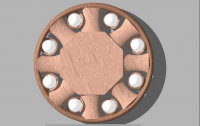








A ball bearing is a type of rolling-element bearing that uses balls to maintain the separation between the bearing races.
The purpose of a ball bearing is to reduce rotational friction and support radial and axial loads. It achieves this by using at least two races to contain the balls and transmit the loads through the balls. In most applications, one race is stationary and the other is attached to the rotating assembly (e.g., a hub or shaft). As one of the bearing races rotates it causes the balls to rotate as well. Because the balls are rolling they have a much lower coefficient of friction than if two flat surfaces were sliding against each other.
Ball bearings tend to have lower load capacity for their size than other kinds of rolling-element bearings due to the smaller contact area between the balls and races. However, they can tolerate some misalignment of the inner and outer races.
Although roller bearings had been developed since ancient times, the first modern recorded patent on ball bearings was awarded to Philip Vaughan, a Welsh inventor and ironmaster who created the first design for a ball bearing in Carmarthen in 1794. His was the first modern ball-bearing design, with the ball running along a groove in the axle assembly.
Jules Suriray, a Parisian bicycle mechanic, designed the first radial style ball bearing in 1869,which was then fitted to the winning bicycle ridden by James Moore in the world's first bicycle road race, Paris-Rouen, in November 1869.
Ball bearings became so widely used in factories,vehicles,and other machinery,that during world war||,the Allies made a concerted effort to bomb German ball beraing plants in order to disrupt the german war effort.The Germans had astutely stockpiled millions of bearings and were able to continue supplying factories despite ball bearing production being halved.
These days,for applications with high load,speed and/or precision requirements,ball bearings are increasingly being replaced by fluid bearings,which use a layer of gas or liquid to support the load.